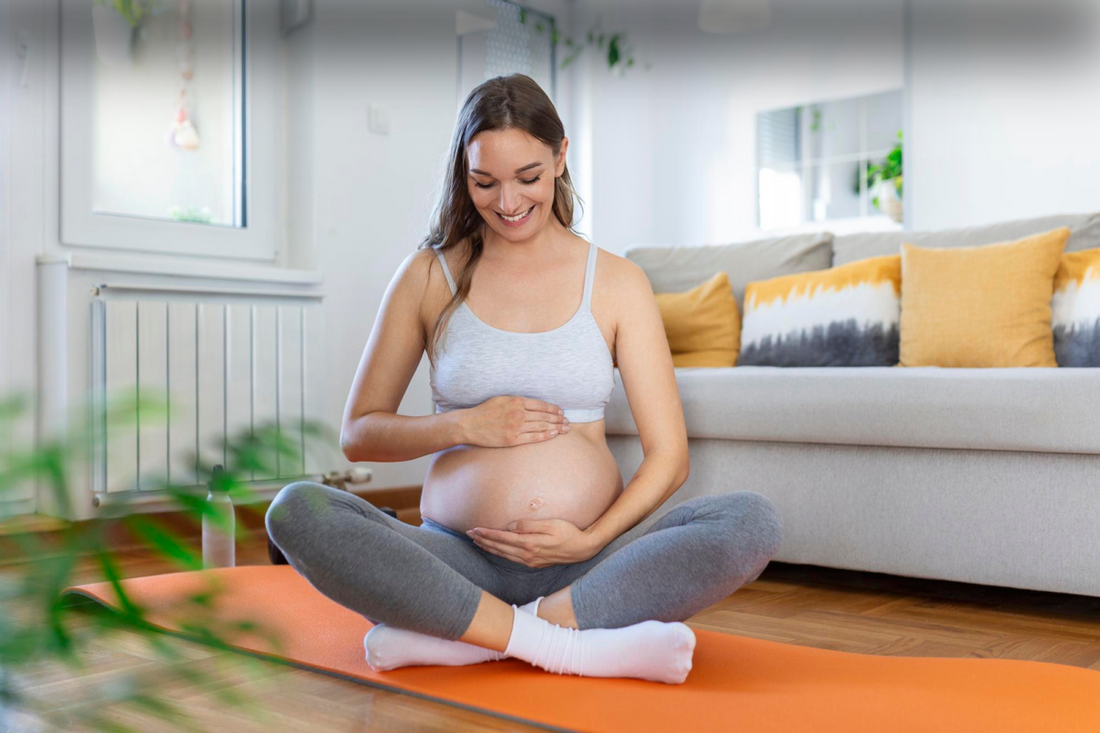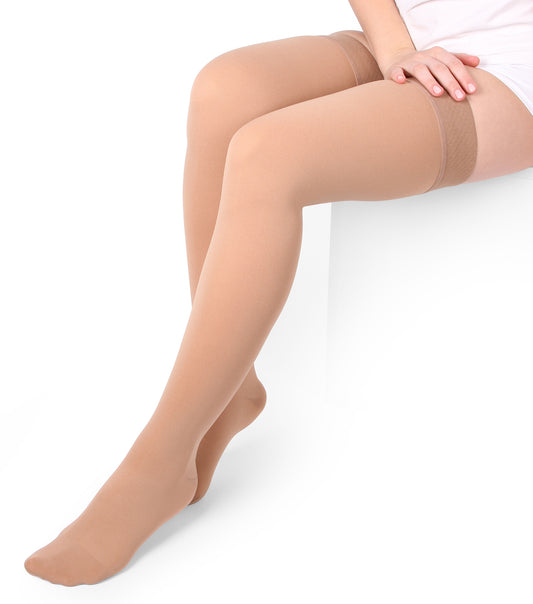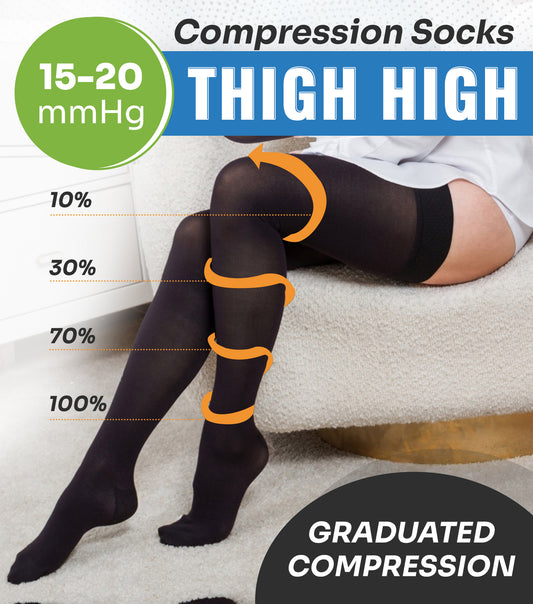

Featured Products
-
20-30 mmHg Compression Stockings Thigh-High, Closed Toe
Regular price $24.99Regular price Sale price $24.99Unit price -
15-20 mmHg Compression Stockings Thigh-high, Closed Toe
Regular price $24.99Regular price Sale price $24.99Unit price -
Anti-Embolism Stockings Thigh High, 15-20 mmHg, White
Regular price $14.99Regular priceUnit price$16.99Sale price $14.99Sale
Pregnancy is divided into three trimesters, each of which is distinguished by distinct fetal changes. At 40 weeks, a pregnancy is considered full-term; children born before the end of week 37 are termed preterm. Premature infants may struggle with growth and development, as well as respiratory and digestion issues.
-
The First Trimester (0 to 13 Weeks)
The first trimester is critical for your baby's development. Your baby's bodily structure and organ systems grow throughout this time. During this time, the majority of miscarriages and birth abnormalities occur.
-
Trimester Two (14 to 26 Weeks)
The second trimester of pregnancy is commonly referred to as the "golden period" because many of the negative symptoms of the first trimester of pregnancy vanish. You should feel less nauseated, have better sleep habits, and have more energy throughout the second trimester. However, you may have a slew of new symptoms, including back pain, abdominal pain, leg cramps, constipation, and heartburn.
The third trimester is the home stretch as you prepare for your baby's birth. The foetus continues to grow in weight and size, and the body systems complete maturation. You may feel more uneasy now as you gain weight and experience false labor contractions (called Braxton-Hicks contractions).
In preparation for the big day, it is a good idea to start taking childbirth classes during the third trimester. This is especially true for first pregnancies.
The Third Trimester: Body Changes
As their due date approaches in the third trimester, some women become increasingly uncomfortable. As the foetus grows in size and crowds the abdominal cavity, some expectant mothers have difficulty taking deep breaths or getting comfortable at night to sleep, while others are pain-free as they eagerly await the arrival of their child.
The following are some of the changes and symptoms you may experience during your third trimester:
- Your foetus emits body heat, which causes you to feel hot due to increased skin temperature.
- The increased urinary frequency returns as a result of increased pressure on the bladder.
- As the foetus presses on the main vein that returns blood to the heart, blood pressure may fall.
- As you continue to retain fluids, swelling of the ankles, hands, and face (called oedema) may occur.
- Due to increased hormone stimulation of hair follicles, hair may begin to grow on your arms, legs, and face. Hair may feel coarser as well.
- Leg cramps may occur more frequently.
- In preparation for childbirth, Braxton-Hicks contractions (false labor) may occur at irregular intervals.
- Stretch marks on the stomach, breasts, thighs, and buttocks are common.
Pains during the Third Trimester of Pregnancy

Abdominal or stomach pains during pregnancy are extremely common and can occur at any time. Most of the time, they are not causing concern. However, they can occasionally indicate a more serious condition.
It is essential to know what to look for during each trimester and when to seek assistance.
After 28 weeks
It is common to experience discomfort during the final stages of pregnancy. By the third trimester, you may experience Braxton Hicks contractions.
This does not occur regularly. Typically, they last between 30-60 seconds. They are not labour pains, nor are they typically intense. You may experience discomfort instead of pain.
Constipation is another cause of third-trimester abdominal pain. Your expanding baby and womb are now exerting pressure on your abdomen. This may make it more difficult to defecate.
The consumption of high-fiber foods can be helpful, but your doctor, midwife, or pharmacist may recommend a laxative.
When to seek Medical Assistance during the Third Trimester
Contact your physician, the maternity unit, or the hospital if:
- If you experience pain when you urinate, you may have a urinary tract infection.
- Blood in the urine, as well as foul-smelling or cloudy urine, could indicate a urinary tract infection.
- Have severe abdominal pain or if your stomach is tender to the touch.
- Experiencing any vaginal bleeding? (this could be a sign of problems with your placenta).
- Preeclampsia symptoms include pain in the upper abdomen or chest, headaches, swelling of the hands, feet, and face, and blurred vision.
- Have itching, severe nausea or vomiting, or yellowing of the whites of your eyes - these could be signs of liver or gallbladder problems notice any change in your baby's movements feel leaking or a gush of fluid and are less than 37 weeks pregnant - this could be a sign that your waters have broken prematurely (preterm rupture of membranes).
- Fever (a temperature of 38 degrees Celsius or higher) may be an indication of infection.
Foods to Consume During the Third Trimester
What foods should you avoid during your third trimester? Vitamin C, fiber, vitamin K, and thiamine (vitamin B1) are especially important from 28 weeks to delivery. You'll get enough of these nutrients from your food if you eat a varied, healthy diet. Remember that you require an additional 200 calories per day during this stage of your pregnancy.
1. Fruit

Consume some fresh fruit. It's high in vitamin C as well as fiber. Wash and slice fruit such as kiwis, strawberries, melons, and papaya before bringing them to work or storing them in the fridge for a quick snack. If you're short on time and going out for the day, just throw a piece of fruit in your bag.
Vitamin C aids in the absorption of iron from food and maintains the health of your immune system. It also aids in the development and proper functioning of the placenta.
2. Salad with Ham and Tomatoes
Thiamine can be found in thin slices of lean ham. If you're a vegetarian or vegan, try roasted sweet potato, which is high in thiamine. Combine with a vitamin-rich salad of tomatoes, radishes, sweetcorn, and lettuce for a delicious, healthy meal.
Thiamine aids in the release of energy from food.
3. Chilli Bean
To make a spicy chili that's high in thiamine, iron, and fiber, use canned kidney, cannellini, or black-eyed beans. For vitamin C, add fresh tomatoes and peppers.
Constipation is a common issue at this point. Drink plenty of water, decaffeinated beverages, juices, or soups, and eat plenty of fibrous foods.
4. Lentils
Cooked lentils add a tasty thiamine and fiber boost to dhals, soups, stews, and salads. If you're buying soup, make sure it's low in salt and that you thoroughly heat it before eating.
5. Nuts and Seeds
If you don't like snacking on seeds and nuts, thiamine-rich sunflower seeds and nuts like walnuts and hazelnuts are added to some bread, breakfast cereals, and cereal bars. They also have important omega-3 fats.
When selecting muesli, look for one with no added sugar and a handful of fresh fruit, such as raspberries or kiwi fruit, for added vitamin C.
6. Baked Beans with Wholemeal Toast
Serve baked beans with thiamine on wholemeal or seeded toast. The fiber in this snack will help keep constipation at bay while also keeping your energy levels stable throughout the day.

7. Salad with Avocados
Avocados are high in vitamin C, vitamin E, and fiber. Slice the avocado and combine it with walnuts, vitamin K-rich rocket or watercress, and mango or orange segments to make an avocado salad. You can also add a dressing if you want.
8. Yeast Extract
Thiamine and other nutrients are added to yeast extract. Spread a thin layer on toast and serve with tomatoes, cottage cheese, peanut butter, or mashed avocado as desired.
Best Exercise for Your Third Trimester
The third trimester, weeks 28-42, is the final stretch of your pregnancy, and it often feels long. This is because your body is physically stretched and pushed to its limits during the third trimester of pregnancy. In the third trimester, you may experience fatigue, back pain, difficulty sleeping, frequent urination, swelling, shortness of breath, round ligament pain, heartburn, and Braxton hicks. The good news is that regular exercise during the third trimester is an excellent way to reduce some of the symptoms and discomfort.
Is it Secure?
Normal, healthy pregnancies are recommended by the American Congress of Obstetricians and Gynecologists (ACOG) to engage in exercise during pregnancy. Before beginning an exercise regimen, it is essential to consult with your OB or midwife to ensure that it is safe. Certain high-risk complications render exercise hazardous.
What are the Advantages?
Many uncomfortable and unpleasant pregnancy side effects, such as back pain, constipation, fatigue, and swelling, can be mitigated by exercise. It can also reduce your risk of complications during pregnancy, such as gestational diabetes, preeclampsia, and cesarean section, and improve your and your baby's heart health.
Types of Exercise
In general, it is not recommended to begin a new high-intensity exercise routine during pregnancy. In other words, it is not advisable to begin a brand-new running or Cross fit regimen during any trimester of pregnancy. However, you can begin exercising at any time during your pregnancy, even if you've never been physically active before. Start slowly and under the supervision of a medical professional. Considering your balance, belly size, and other physical changes, the following exercise routines are ideal for the third trimester.
1. Walking

This is the easiest and most accessible pregnancy exercise. Ensure that your walking shoes are supportive and comfortable. Visit a running shoe store for a free consultation on the type of support your feet and walking style require. A trained salesperson will be able to determine whether you need a shoe with a higher or lower arch. If your lower back or pelvis aches while walking, try wearing a back or pelvic brace for additional support. Consult a prenatal physical therapist to determine the necessary support and strengthening exercises for severe back or pelvic pain.
2. Swimming or Aquatic Aerobics
Swimming is an excellent form of exercise during pregnancy because the water alleviates the weight and stress on your joints and ligaments, allowing you to move with minimal discomfort. Swimming laps or performing water aerobics, on your own or in a class, is a fantastic way to raise your heart rate safely and comfortably.
3. Prenatal Yoga or Pilates
Yoga and Pilates are ideal during pregnancy not only due to the gentle movements that are safe for pregnant women, but also due to their emphasis on strengthening the core and pelvic floor, which aids in stability, comfort, and labour. Be sure to search for a pregnancy-specific class with instructors who are certified in teaching prenatal classes when looking for a good class to attend.
4. Physical Exercises and Muscle Toning
Simple exercises such as squats, arm lifts with light dumbbells, wall push-ups, lunges, leg lifts, etc. are great for toning muscles and increasing strength because they are low impact and simple to perform at home.
5. Pelvic Floor Exercises
If you are only going to exercise one muscle group, it should be your pelvic floor. While pelvic floor exercises may not provide a good workout for the entire body, they do strengthen the pelvic floor, which is essential during pregnancy, labor, birth, postpartum, and for years to come.
Conclusion
During this stage of pregnancy, a woman's emotions shift from fatigue and anxiety to excitement about the baby.
As the third trimester progresses, your baby will have a greater chance of survival if they are born early. In the third trimester, you will have more checkups with the midwife in order to monitor your and your baby's health.
You can benefit from assistance during the third trimester. Belly bands can help with all of the above. The purpose of pregnancy belly bands during pregnancy is to support the lower back and abdomen. Active pregnant women may derive many benefits from these flexible support garments, particularly during the second and third trimesters.






